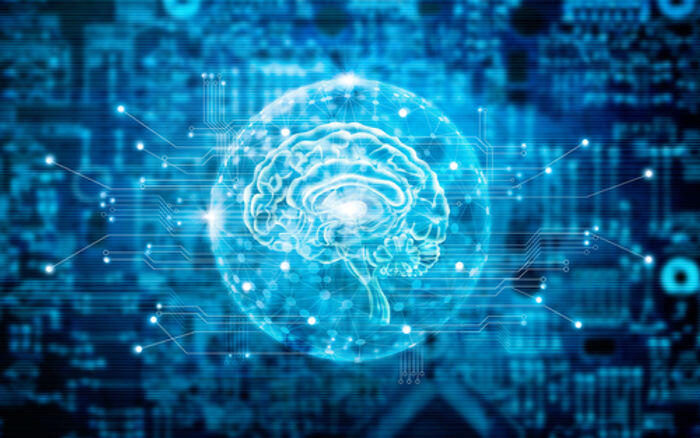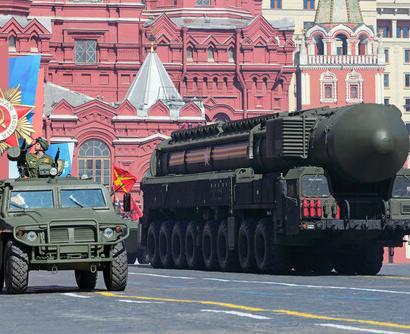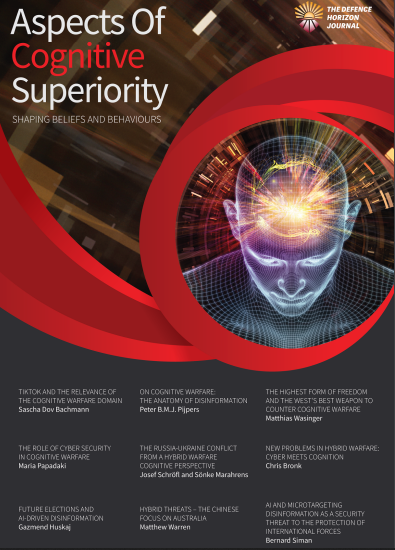Abstract: The modern military operating landscape could be described as a dynamic, complex, multi-domain system. NATO recognizes five operational domains, namely land, air, sea, cyber and space. However, the 6th domain, the cognitive domain, is still widely overlooked and eliminated from the agenda. Cognitive Warfare (CW) is capable of multiplying the destructive impact on the adversary and achieving the desired end state even without realizing it occurred.
Problem statement: How should states identify CW instruments and integrate CW-related threats into National Defence strategies?
So What?: States should identify and classify the areas of CW’s diffusion. They have to consistently evaluate and track CW’s means and ends and adjust their agenda/national defence approaches accordingly. It is vital to consider the terrain – such as the human mind – with all of its complexities. Beyond the national security interests, it is the collective responsibility of individual states’ effort to the international community’s input to jointly deal with it unless the tendency is manageable.
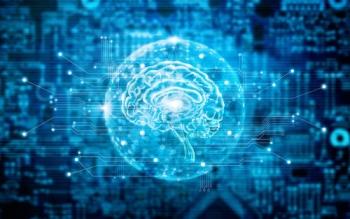
Source: shutterstock.com/PopTika
“If you know the enemy and know yourself, you need not fear the result of a hundred battles. If you know yourself but not the enemy, for every victory gained you will also suffer a defeat. If you know neither the enemy nor yourself, you will succumb in every battle.”
Sun Tzu, The Art of War
Reflexive Control Strategy: Means and Ends
In the academic context, the term Reflexive Control (RC) is defined as “a means of conveying to a partner or an adversary specially prepared information to incline him to voluntarily make the predetermined decision desired by the initiator of the action”.[1] The content echoes and conveys the elements of the strategic thinking of Sun Tzu, particularly in the aspect of employing stratagems in conducting information warfare. The theory, as such, originated in the Soviet Union era in the 1960s and has ever since evolved. Timothy Tomas specifies the trajectory of RC’s development encompassing the research, practical orientation, psychological-pedagogical and psycho-social stages.
Reflexive Control is defined as a means of conveying to a partner or an adversary specially prepared information to incline him to voluntarily make the predetermined decision desired by the initiator of the action.
The contemporary understanding and practical application in the framework of Russian Military Strategy offers a helpful outlook to fully capture its essence compared to previous relatively experimental periods. The scope of the concept covers reflexive systems and processes. The first is focused on the relevant actors’ perception of the system and their mental image. In contrast, the second aims to identify the adversary’s mentality and sophisticate the calculus of decisions.
Regarding the objectives of the strategy, to name a few, obviously, the ultimate goal is to achieve a state of reflexive control itself, manage the opponent’s decision-making algorithm, determine/command situational awareness and configure the information environment (physical, information and cognitive realms). Concerning methodology, two modes of implementation could be mentioned; the one is constructive (creative) – gradually inducing the enemy to take desired steps, while the destructive approach intends to degrade the rival’s decision-making. Each of those samples has its exclusive features, types and distinctive characteristics.
Methods and Targets – Constructive/Creative Method
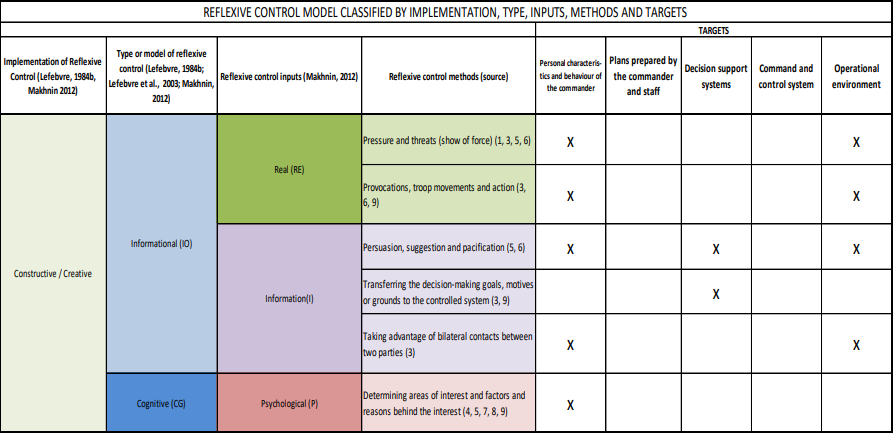
Source: Origins, Evolution and Application in the Framework of Contemporary Russian Military Strategy, 2020, 72.
Among the existing differences between constructive versus destructive attitudes, it can be noted that the creative way requires more time and is applicable in the long-term perspective at higher strategic echelons (targets the commander’s personal characteristics). In contrast, in the case of the destructive method, it is directed across the full spectrum of command and control systems.
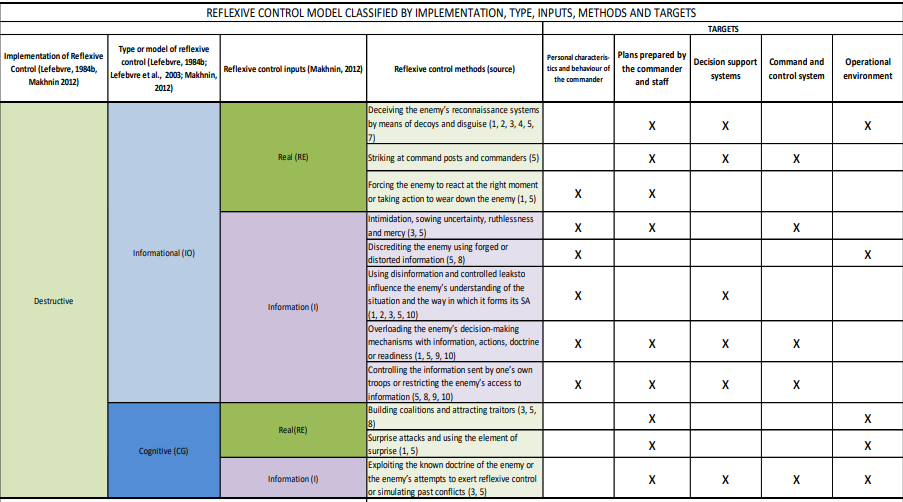
Source: Origins, Evolution and Application in the Framework of Contemporary Russian Military Strategy, 2020, 73.
Methods and Targets – Destructive Method
By analyzing the targets’ vertical cells of the scheme, it is apparent that in both cases, the military branch of the defence system enjoys superiority over other sectors. It is not a sustainable path because it is a long-run investment, which requires a huge effort to get familiar with one’s operational doctrines. An increased risk of backfire and visibility of the boots on the ground follows it.
There are essential static factors between the means and ends, like limited time for manoeuvre, scarce/insufficient resources, dynamic security environment, and century’s type of tendencies/challenges/innovations. These factors bring tension and encourage system elements to adjust accordingly. In this sense, Reflexive Control Strategy (RCS) changes the playground from home to the host’s operational domains and exploits counterparts’ national assets (so-called DIME element– an acronym for diplomatic, informational, military and economic dimensions, which in turn combines the instruments of national power).
Reflexive Control Strategy changes the playground from home to the host’s operational domains and exploits counterparts’ national assets.
First and foremost, the civil segment is a less explored and widely overlooked facet of the strategy. Secondly, there is a lack of understanding regarding the societal costs of CW. Thirdly, existing defence approaches do not contain any explicit cognitive footage. Fourthly, the shortage of available materials/expertise complicates the progress for proper situational awareness.
Neurons Over Bullets
There is no universally accepted definition of Cognitive Warfare. The notion is usually confused with Information, Psychological, or even Cyber warfare. To avoid this peril, CW is formulated as a type of warfare which intends to “alter the cognitive process of the adversary, to exploit biases or mental automatisms, to provoke distortions of representations, alterations of the decision or even inhibitions of actions, and to bring about disastrous consequences”.[2]
CW is located at the interface of info-psycho-cyber domains and converges their constituting elements. Unlike traditional instruments of war, CW is a non-kinetic, irregular mechanism that consistently intervenes in individuals’ mental processes (neural network system) all the way from peacetime public opinion shaping to wartime decision-making. CW explicitly operates below the threshold of an armed conflict and functions as a multiplier of an effect, modifying perceptions of reality in predetermined frames. Flexibility and integrity of brain-working techniques alongside a target’s natural impulse increases its competitiveness/likelihood of success compared to other tools. So, the synergy of CW has proven potential to outweigh the overall conventional capacity in the long-term. It is especially relevant in the transition phase “from wars of attrition to wars of cognition”.[3]
Procedurally, it generates info by subtly mapping the human terrain with its peculiarities (creating prototypes, identifying the psycho-social contours of the populace, defining the pattern of the cultural factors) and installs it in the physical realm. CW pursues the principles of infiltration without the target’s consent and wins without fighting. Considering that there is so much emphasis on the human mind, decision-making ability/inability and behaviour feedback, it is reasonable to get familiar with some of the basics of brain/neuroscience and elementary terminology.
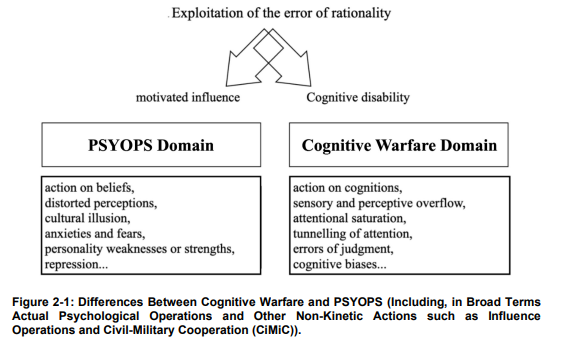
Source: Cognitive Warfare: The Future of Cognitive Dominance, 2021.
The Adaptive Brain Theory
The adaptive brain developed out of centuries-long evolutionary pressures, such as shortage of resources and threatening environmental conditions. Consequently, the brain progresses in a way that maximizes adaptability to diverse environmental factors and regulates internal needs and external demands. The organization of the brain consists of functionally interdependent networks to reduce the prediction error. Interoceptive systems include information about internal needs (pain, heartbeat, blood pressure), while exteroceptive focus on external circumstances. The perception of the world, relatively, is a result of those two systems’ interaction and the way information has been exchanged.
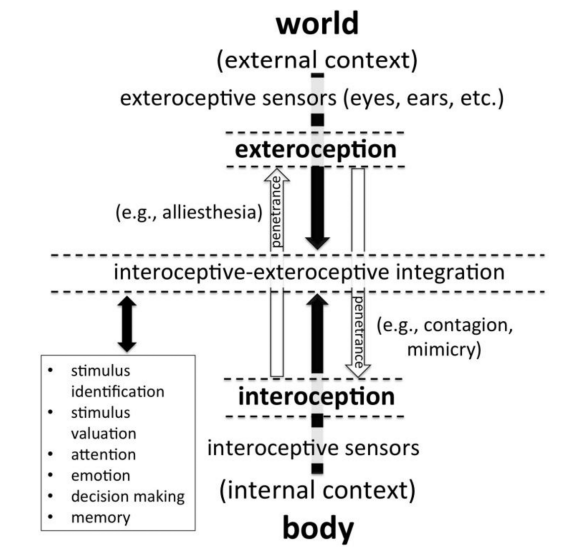
Source: “Interoceptive Dysfunction: Toward An Integrated Framework for Understanding Somatic and Affective Disturbance in Depression”, 2025, 79.
Ultimately, humans developed three key adaptation responses: quick emotional, slower cognitive, and seeking others’ help to cooperatively counter the source of danger. According to the adaptive brain theory, “the more the brain can minimize prediction error and accurately predict outcomes …, the better it will be at anticipating and adequately responding to challenge and threat efficiently and rapidly, thus increasing adaptation and survival”.[4] The art of adaptability lies at the heart of aligning with incompatible needs and envisaging conflicting requirements.

As the brain is tasked with obtaining the harmonious coexistence of internal needs and external demands respectively, it determines the course of action (adaptive strategy) to achieve this end state. It detects the type of network, in the case of DMN, is “automated responses to routine situations with learned rules” – then it follows the strategy of maintaining homeostasis (stability of the body). In terms of attention networks, which imply “increased analysis of external cues and enable slow response systems for situations with harder-to-predict outcomes and fewer or no established rules”, require stability through change to adapt to the environment (survival, well-being).
Decision-Making Dichotomy
In the decision-making process, “our choices are guided by the expected impact they will have on our affective state”.[5] The affective state is explained as “how we feel at any given point in time, a combination of valence (pleasant to unpleasant) and arousal (low energy to high energy)”. In turn, affective itself is highly influenced by “the activation of neural circuits that evolved to ensure survival”.[6] The character of the circuits determines the decision and possible behaviour.
For example, “Our motivation arises from these circuits, and motivational arousal is the foundation of emotion”.[7] A threatening environment triggers unpleasant arousal that equals negative affect, and a contrary favouring situation is associated with pleasant affect. Logically, when facing a dilemma, individuals go for an option that increases pleasurable outcomes and decreases unpleasant results.
Cognition and Memory Formation
Cognition is a fundamental element in the brain system responsible for problem-solving. It “integrates with emotional responses by including knowledge and experience from previous encounters with similar situations”.[8] With cognition, people imagine future scenarios and probable courses of action. Memory is explained as “the cognitive storage place for all of your past experiences and knowledge”,[9] and simply formulating presents an “ability to retain information and recall it later”. It helps individuals to make sense of reality, plays a key role in shaping their identity and accordingly navigates personal thoughts/behaviours. Although memories are malleable, once something is recalled, it changes in accordance with the current emotional condition.
Cognition is a fundamental element in the brain system responsible for problem-solving. It integrates with emotional responses by including knowledge and experience from previous encounters with similar situations.
Scientifically speaking, memory formation is quite a complex process because of systematic interactions and transmission of information between billions of neurons.
The memory creation undergoes several interchangeable stages with spillover effect until it is finalized:
- Encoding – information processing and the ways through which it is analyzed (visual, feel, acoustic, semantic – understanding the meaning);
- Storing – record and placing it in storage, or, in other words, it locates, measures and defines the duration of encoded information (STM & LTM); and
- Retrieving – calling back/accessing stored information (recall and recognition).
There are two types of memories, short-term (STM) and long-term (LTM). The first stores just several pieces (5-9) of information, which last only for seconds (15-30) and later, it can be transferred to long-term memory (LTM) by rehearsal (constant repetition). LTM is overarching and possesses infinite remembering capacity. Both described scientific patterns are evolutionary-driven processes and illustrate how humans’ brains are naturally designed and how they function. Accordingly, it gets easier for the observer to purposefully select an information package that will go through this three-layered system and estimate the sustainability period. In terms of RC strategy launched through cognitive/informational inputs, undoubtedly targets long-term memory to gradually spread predetermined narratives.
It gets easier for the observer to purposefully select an information package that will go through this three-layered system and estimate the sustainability period.
Awareness and analysis of adaptive brain theory, the pathway of perception, characteristics of neuroplasticity, information processing trajectory and variables in the decision-making period combined provide valuable framework and expertise for scientific assessment of the CW impacts on behaviour strategy at a variety of levels. It sets helpful preconditions for the understanding of the phenomenon of confirmation bias, fall for misinformation/fake news and its correction effort. However, the metric of RCS’ success is practically based on the ratio of effects on the community, patterns of their responsiveness and affirmation of the cause.
Case of Georgia: Defence Approach and Assessment of Information Environment
Georgia’s defence approach is based on Total Defence strategy (TDS), which combines the whole-of-government, whole-of-society and interagency efforts to defend the homeland from any form of threat or crisis. In the case of Georgia, TDS has four lines of effort (LoE) that are aimed at achieving and sustaining national resilience, which, in turn, presents a foundation for resistance.
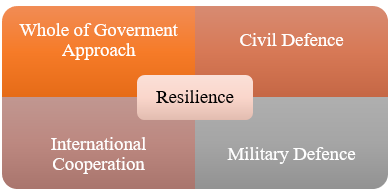
LoE of Georgia’s Total Defence Model; Source: Author
In the civil defence component, whole-of-society engagement and, in general, societal factors are vital for successfully implementing this particular pillar of the strategy. The society possesses a dualistic nature. On one hand, the community itself presents one of the most vulnerable and easily targetable areas. On the other hand, it is an opportunity to turn a given feature into a strength and, even further, a force multiplier for other dimensions to evolve and accomplish resilience toward the full spectrum of the competition continuum. It is a matter of the art of transformation and navigation from one condition to another to get closer to a favoured end state. The level of support from the citizens profoundly impacts defence building and its advancement perspective. Trust, cohesion and motivation are bedrock principles for establishing viable TDS. The more educated, informed and enabled citizens are, the more likely they will be aware, capable and committed to get involved in defence/deterrence-related activities.
At the initial stage, awareness is detrimental because the rest of the chain logically follows the path. In the adaptive brain theory part, behaviour strategy is circumscribed by the impact of the outcome on the affective state, in either a positive or negative way. Once the threat identification procedure is completed and the time has come to find a solution to survive/adapt to an altered environment, there are at least two. One way is to achieve individual psychological/physical resilience (capacity building), and the other is a collective response to the source of uncertainty to restore the status quo.
In conjunction with the RCS launched by Russia, it is clear that intentional and purposeful injects (predetermined information) that form IE’s forecast serve one major objective to gradually entrap by knowing human reflexes and national specifications. Conversely, understanding the working principle of RCS and CW mechanics suggests a window of opportunity to take countermeasures/preventive steps.
In the adaptive brain theory part, behaviour strategy is circumscribed by the impact of the outcome on the affective state, in either a positive or negative way.
Information Environment (IE) Assessment
The information environment is defined as “the aggregate of individuals, organizations, and systems that collect, process, disseminate, or act on information”.[10] The IE encompasses three dimensions, such as physical, informational and cognitive, that are interdependent, overlapped and work in an integrated manner.
Information Environment Elements and Dimensions
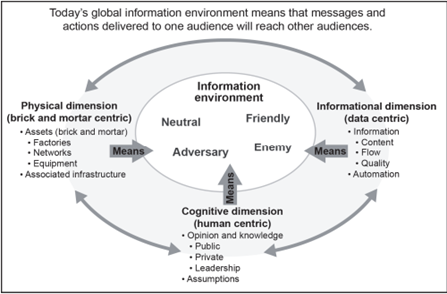
Source: FM 3-13, Inform and Influence Activities, 2013, 19.
In the information environment’s domain synchronization model, “information systems in the physical domain create and direct the flow of information in the information domain which, in turn, affects human perceptions, attitudes, and ultimately decision-making in the cognitive domain”.[11] Consequently, “the decisions made in the cognitive domain are transmitted as orders and intent through the information domain and executed as actions in the physical domain”.[12]
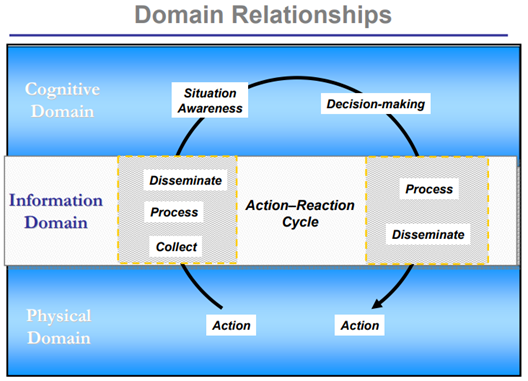
Source: “Applying the Domains of Conflict to Information Operations”.
Accordingly, the case of Georgia will be evaluated through the lens of a three-layered IE’s design. It starts with the analysis of the info domain (content, flow), followed by the physical field (networks, systems) and culminates in cognitive areas (attitudes, perceptions, awareness).
Based on the latest public opinion survey conducted by the National Democratic Institute (NDI) in 2023, the following findings emerged: low public confidence in institutions, scepticism is the highest among young people, majority of the population (51%) do not trust any of Georgian TV channels, and there is an increased demand for visibility of repressed/security concerns. The Caucasus Research Resource Centers published a dataset for the main sources of information in Georgia in 2022, according to which TV remains the primary source of information, followed by social media/internet.
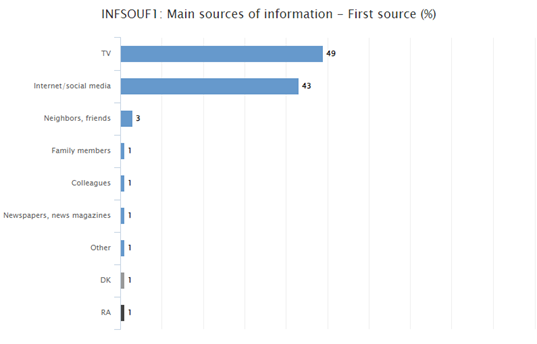
Information Flow in Georgia; Source: The Caucasus Research Resource Center, 2022.
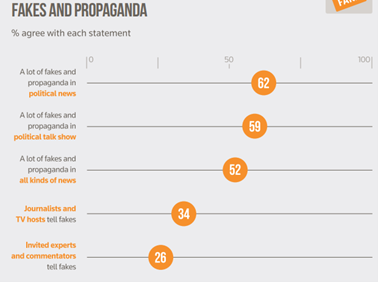
Source: ”Anti-Western Propaganda”, MDF, 2020.

Source: “Media Consumption and Audience Perception”, Thomas Reuters Foundation.
Media Development Foundation’s s report on Anti-Western Propaganda in 2020 identified the media as the major source of disinformation narratives. The structure of the narratives suggests valuable insight into the intentions and meanings of message boxes. The first is a positive or constructive strategy to establish a coherent narrative at the societal level or with a selected group of people, and the second is negative disruptive – “attempt to prevent the emergence of a coherent narrative or weaken the existing one”.[13]
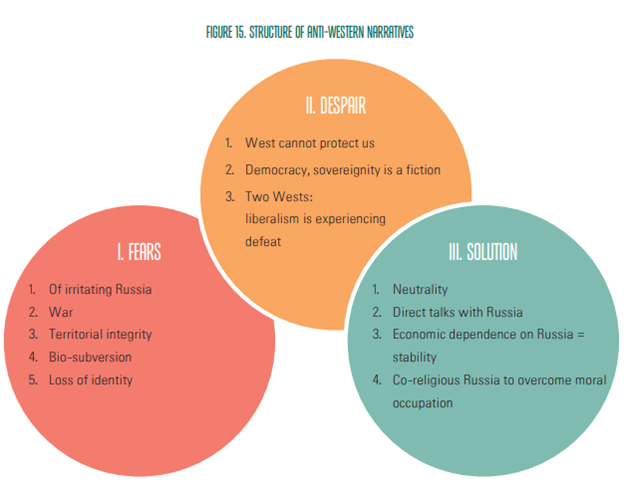
Source: Anti-Western Propaganda, MDF, 2019.
Georgia is characterized by the richness of its cultural diversity and demographic composition. However, Russia favours from this situation in that it maps specific geographical regions and, through the constructive/destructive narrative, installs despair, uncertainty, a sense of insecurity and offers solutions for underrepresented interests to be heard. Consequently, “the analysis of dynamics in the past five years shows a gradual increase in the statements favouring Russia as a power that has no alternative”[14] (cognitive outcome) must act accordingly.
Georgia is characterized by the richness of its cultural diversity and demographic composition. Russia favours from this situation in that it maps specific geographical regions and, through the constructive/destructive narrative, installs despair, uncertainty, a sense of insecurity and offers solutions for underrepresented interests to be heard.
Operational Picture in Practice and National Security Challenges
- Consistency of mainstreaming predetermined information in the form of constructive/destructive narratives significantly shapes information environment (three-dimensional theatre), conditions the necessity for adaptability (installing fear – uncertainty) and responsive behavioural law or high-risk strategy (CAR postulate – accommodate, cooperate, resist) that is highly likely in line with adversary’s (Russia) interests and end state;
- The quality and quantity of consumed information (accurate, coherent versus fake news, des/misinfo) impacts brain plasticity that adjusts accordingly and the memory formation from short-term to long-term. Hence, it could be assessed as a generational matter in the long run perspective;
- CW operates covertly and without the one’s consent that it is actually happening because of its algorithm; the brain (through particular neural networks) comprehends environmental (new security order) and behavioural changes as its naturally/evolutionary inherited feature;
- Externally and intentionally stimulating (content of narrative) certain neural pathways gradually cause changes in mentality and identity (in positive affect – ensured, negative affect – questioned);
- The outcomes of CW account for distrust, discouragement and partial/fragmented awareness about the reality (less capable and committed community). Obviously, in this manner, CW erodes the idea of whole-of-society effort (awareness scale – passive/proactive action), as solid ground for resilience, hinders the defence capacity-building process and undermines the realization of TDS (as it was aimed at balancing existing asymmetry with an opponent through the integrated use of available means);
- The tangible results could be observed in the lack of societal support in enhancing defence-related initiatives and multiscale passive engagement (initially small amounts – with huge impact and the potential for turning into hardly manageable theatre).
Recommendations
- Increased awareness, acknowledgement and recognition of the cognitive domain as a clandestine area of operations, previously widely overlooked and less explored, currently requires adequate and in-depth analyses and incorporation into the national security list of documents with equivalent prioritization;
- Timely identification, analysis and categorization of the societal costs of cognitive warfare in the short/long term perspectives at a variety of levels (tactical, operational, strategic);
- Countering CW threats through the lens of Total Defence could be amplified by including an inter-/multidisciplinary approach (including the views from sociology, psychology, neuro/behavioural science, data/digital expertise) in situational awareness and understanding of human terrain (as it mainly deals with societal factors) in defining the roadmap for building resilience and resistance infrastructure.
Nino Tsikhelashvili, research interests: War Studies, Irregular Warfare (especially Unconventional Warfare), Defence Approaches –Total/Comprehensive Defence Strategy; Resilience and Resistance Affairs. Earlier publications: ”Private Military Companies: Western and Russian Approaches”; “The Role of Estonian Defence League in the Realization of its Total Defence Strategy”, “Cognitive Warfare and Its Influence of National Will to Fight”, “Interdependency and Significance of Force Instrument and Resources in Strengthening Georgia’s Self-Defence Capabilities”. Academic Fields: International Relations, Security Studies. The views contained in this article are the author’s alone.
[1] Margarita Jaintner, “Applying Principles of Reflexive Control in Information and Cyber Operations,” Journal of Information Warfare, no.15, (Fall 2026): 7-16.
[2] Bernard Claverie, and François Du Cluzel, “Cognitive Warfare”: The Advent of the Concept of
“Cognitics” in the Field of Warfare,” NATO Science and Technology Organization, (2021): 3-9.
[3] Air, Space & Cyber Symposium remarks by General David L. Goldfein, Air Force Association, September 2017, 8-9.
[4] Patrick R. Steffen, Dawson Hedges, and Rebekka Matheson, “The Brain Is Adaptive Not Triune: How the Brain Responds to Threat, Challenge, and Change,” Departments of Psychology and Neuroscience, Brigham Young University, (Spring 2022): 1-9.
[5] Idem.
[6] Idem.
[7] Idem.
[8] Idem.
[9] Jess Sides, “The Science of Memory,” Reporter, February 24, 2020, https://reporter.rit.edu/features/science-memory.
[10] “Inform and Influence Activities,” Department of the Army Washington, DC, Field Manual, no. 3-13, (January 2013): 18-20.
[11] By Robert Cordray III, and Marc J. Romanych, “Mapping the Information Environment,” Joint Information Operations Center, (Summer 2005): 1-4.
[12] Idem.
[13] Tamar Kintsurashvili and Sopho Gelava, “Anti-Western Propaganda,” Media Development Foundation, 2019, 10-45.
[14] Ibid., 13-45.


